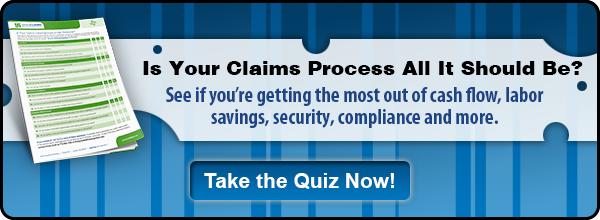 Now would be a good time to get back to the basics, the essentials, of what a clearinghouse is and offers. “Clearinghouse 101” – an introduction to the some of the critical features and benefits of a claims clearinghouse. Whether you are using one today or not, take a peak. You may find some of the following tips and points useful.
Now would be a good time to get back to the basics, the essentials, of what a clearinghouse is and offers. “Clearinghouse 101” – an introduction to the some of the critical features and benefits of a claims clearinghouse. Whether you are using one today or not, take a peak. You may find some of the following tips and points useful.
One portal does it all
A clearinghouse becomes the one-stop shop, the aggregator, for all claims processing actions - all in one portal with a single sign-on to submit, respond to, monitor, and manage all claims submitted to Medicare, Medicaid, Managed Care, private insurances, and other 3rd party payers. Within the portal, billers can make changes or corrections to the claims and have access to DDE, HETS, and claims-in-process.
A claims translator
The clearinghouse takes the claims created within billing software and should run them through a scrubber to make sure that they are compliant with each payer’s requirements. If the clearinghouse find errors, it notifies the billers which claims need what information. Once the clearinghouse verifies that the claims are complete and comply with the payer billing requirements, it converts them into a format readable by the payer and forwards the claims. As a link between the provider and its payers, in essence, a clearinghouse is a claims translator.
Not a billing service
Periodically, someone will ask us if we, a clearinghouse, are a billing service. The straightforward answer is, “No.” A clearinghouse works with a provider's billing service/billers to complete the revenue cycle and to get cash back in your hand.
A convenient tool to monitor, manage, and follow-through
Submitting the claims is one thing, monitoring and follow-through are another. The clearinghouse portal enables you to see into what is happening with the claims once the payer has accepted them. Through the portal, billers can view the entire lifecycle of the claim and take action as needed to keep the claims flow steady.
Create secondary claims automatically
Please refer to this blog to learn more about how a clearinghouse should help to process secondary claims automatically and timely.
Claims data storage
Our clearinghouse, for example, securely stores the data up to 10 years, retrievable for the provider at any time.
Support
Experience and expertise are the foundation of a responsive and reliable support system. A clearinghouse can identify what is acceptable and answer claims submissions and processing questions.
Reports
A clearinghouse should have a core set of useful reports to help billers, their managers, and the executive team to track and trend the claims cycle. The reports offerings should help providers to track their billers and claims.
The bottom line
From a benefits point of view, what does a clearinghouse offer?
- Simplicity - An effective clearinghouse makes the submission and management of claims simple, easy to learn, and monitor – a single location for claims management.
- Efficiency - From clearinghouse.org, we find that “the average error rate for paper claims is 28%. But using the right clearinghouse can reduce that to 2-3%.”
- Control – A clearinghouse delivers a provider-specific portal which serves as an all-in-one centralized location to monitor, manage, and extract necessary information.
- Speed – A clearinghouse facilitates quicker claims turnaround with higher claims success.
- Peace of mind – With a clearinghouse, billers have the confidence that they can track all claims easily throughout the entire claims-based revenue cycle.
It all makes cents.
/Prime-Care-Technologies-Logo.png?width=191&height=55&name=Prime-Care-Technologies-Logo.png)

 Admittedly, the reimbursement process is complicated. Not only must billers identify who is to pay the bill, they have to know how to bill the payer and get paid as quickly as possible. This is especially the case when billing third party payers, such as Medicare, Medicaid, Managed Care, and private insurances. Each has its own requirements as far as coding, bill timing, and claims processing quirks are concerned which seem to change frequently. If billers are having to prepare, process, track, and follow up with claims manually using spreadsheets, phone calls, emails, letters, logs, and on and on, it is no wonder that billers are stressed and overwhelmed, that dollars are left on the table and claims are lost or misplaced. Reimbursement, or revenue cycle management, does not have to be complicated, however. In fact, it can be relatively simple with an automated claims management solution through a claims clearinghouse. But, buyers beware. Let’s take a closer look.
Admittedly, the reimbursement process is complicated. Not only must billers identify who is to pay the bill, they have to know how to bill the payer and get paid as quickly as possible. This is especially the case when billing third party payers, such as Medicare, Medicaid, Managed Care, and private insurances. Each has its own requirements as far as coding, bill timing, and claims processing quirks are concerned which seem to change frequently. If billers are having to prepare, process, track, and follow up with claims manually using spreadsheets, phone calls, emails, letters, logs, and on and on, it is no wonder that billers are stressed and overwhelmed, that dollars are left on the table and claims are lost or misplaced. Reimbursement, or revenue cycle management, does not have to be complicated, however. In fact, it can be relatively simple with an automated claims management solution through a claims clearinghouse. But, buyers beware. Let’s take a closer look.